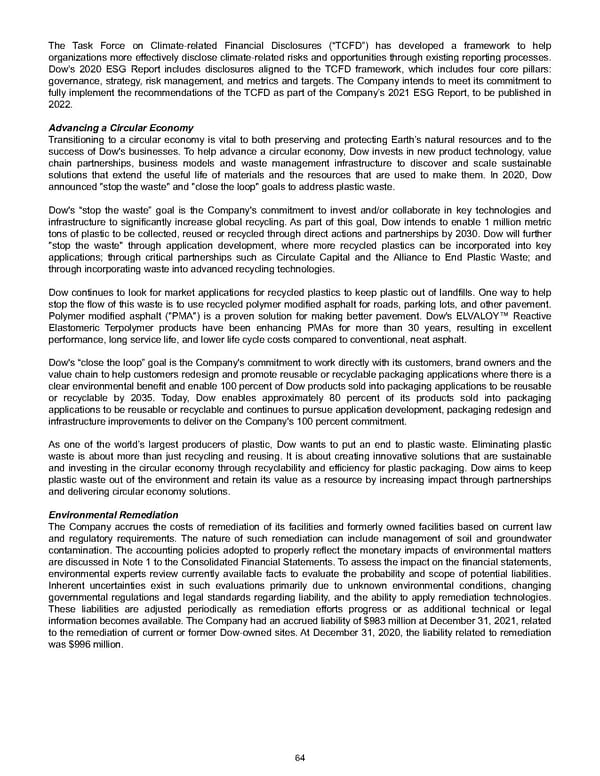The Task Force on Climate-related Financial Disclosures (“TCFD”) has developed a framework to help organizations more effectively disclose climate-related risks and opportunities through existing reporting processes. Dow’s 2020 ESG Report includes disclosures aligned to the TCFD framework, which includes four core pillars: governance, strategy, risk management, and metrics and targets. The Company intends to meet its commitment to fully implement the recommendations of the TCFD as part of the Company’s 2021 ESG Report, to be published in 2022. Advancing a Circular Economy Transitioning to a circular economy is vital to both preserving and protecting Earth’s natural resources and to the success of Dow's businesses. To help advance a circular economy, Dow invests in new product technology, value chain partnerships, business models and waste management infrastructure to discover and scale sustainable solutions that extend the useful life of materials and the resources that are used to make them. In 2020, Dow announced "stop the waste" and "close the loop" goals to address plastic waste. Dow's “stop the waste” goal is the Company's commitment to invest and/or collaborate in key technologies and infrastructure to significantly increase global recycling. As part of this goal, Dow intends to enable 1 million metric tons of plastic to be collected, reused or recycled through direct actions and partnerships by 2030. Dow will further "stop the waste" through application development, where more recycled plastics can be incorporated into key applications; through critical partnerships such as Circulate Capital and the Alliance to End Plastic Waste; and through incorporating waste into advanced recycling technologies. Dow continues to look for market applications for recycled plastics to keep plastic out of landfills. One way to help stop the flow of this waste is to use recycled polymer modified asphalt for roads, parking lots, and other pavement. Polymer modified asphalt ("PMA") is a proven solution for making better pavement. Dow's ELVALOY™ Reactive Elastomeric Terpolymer products have been enhancing PMAs for more than 30 years, resulting in excellent performance, long service life, and lower life cycle costs compared to conventional, neat asphalt. Dow's “close the loop” goal is the Company's commitment to work directly with its customers, brand owners and the value chain to help customers redesign and promote reusable or recyclable packaging applications where there is a clear environmental benefit and enable 100 percent of Dow products sold into packaging applications to be reusable or recyclable by 2035. Today, Dow enables approximately 80 percent of its products sold into packaging applications to be reusable or recyclable and continues to pursue application development, packaging redesign and infrastructure improvements to deliver on the Company's 100 percent commitment. As one of the world’s largest producers of plastic, Dow wants to put an end to plastic waste. Eliminating plastic waste is about more than just recycling and reusing. It is about creating innovative solutions that are sustainable and investing in the circular economy through recyclability and efficiency for plastic packaging. Dow aims to keep plastic waste out of the environment and retain its value as a resource by increasing impact through partnerships and delivering circular economy solutions. Environmental Remediation The Company accrues the costs of remediation of its facilities and formerly owned facilities based on current law and regulatory requirements. The nature of such remediation can include management of soil and groundwater contamination. The accounting policies adopted to properly reflect the monetary impacts of environmental matters are discussed in Note 1 to the Consolidated Financial Statements. To assess the impact on the financial statements, environmental experts review currently available facts to evaluate the probability and scope of potential liabilities. Inherent uncertainties exist in such evaluations primarily due to unknown environmental conditions, changing governmental regulations and legal standards regarding liability, and the ability to apply remediation technologies. These liabilities are adjusted periodically as remediation efforts progress or as additional technical or legal information becomes available. The Company had an accrued liability of $983 million at December 31, 2021 , related to the remediation of current or former Dow-owned sites. At December 31, 2020 , the liability related to remediation was $996 million . 64
 Annual Report Page 73 Page 75
Annual Report Page 73 Page 75